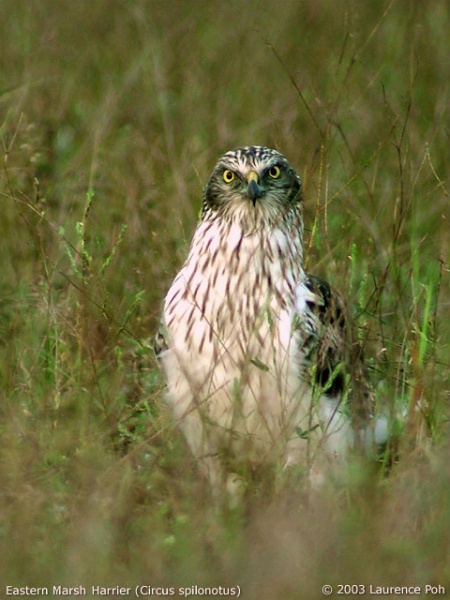| Line 1: | Line 1: | ||
'''Alternative name: Spotted Marsh-Harrier''' | '''Alternative name: Spotted Marsh-Harrier''' | ||
| − | [[Image:Eastern_Marsh_Harrier.jpg|thumb|450px|right|Photo by the late '''[http://www.birdforum.net/gallery/ | + | [[Image:Eastern_Marsh_Harrier.jpg|thumb|450px|right|Photo by the late '''[http://www.birdforum.net/gallery/showgallery.php/ppuser/951/cat/500 Laurence Poh]'''<br />December 2003]] |
;[[:Category:Circus|Circus]] spilonotus | ;[[:Category:Circus|Circus]] spilonotus | ||
'''Includes: Papuan Harrier''' | '''Includes: Papuan Harrier''' | ||
Revision as of 18:00, 27 July 2015
Alternative name: Spotted Marsh-Harrier
- Circus spilonotus
Includes: Papuan Harrier
Identification
It is 48 to 58 cm long with a wingspan of 113 to 137 cm. Like most birds of prey, the female is usually larger than the male.
The male's plumage is variable; typically the head, breast, back and wing-coverts are blackish with pale streaks. The rest of the wing is grey with black wingtips and a white front edge. The tail is grey, the rump is white and the underparts are mostly white.
The female is dark brown with buff streaking on the head and underparts. The rump is often whitish and the tail has dark bars.
Young birds are dark brown with buff on the head and a pale patch on the underwing.
Distribution
Eastern Asia. Breeds in eastern Siberia to the Pacific coast and Sakhalin, in north-east India, throughout China and in Hokkaido and Honshu in Japan. Also breeds in the Philippines, Indonesia and western New Guinea. Resident in southern China but a summer visitor to north of breeding range wintering from southern China, Taiwan and Hainan south to Indonesia.
Taxonomy
Most authors recognize the split of Eastern Marsh Harrier and Western Marsh Harrier (including Clements, 2007; Howard & Moore, 2003; and Sibley & Monroe, 1996), though some treat spilonotus as a race of C. aeroginosus, Marsh Harrier.
Subspecies
There are 2 subsp[1]:
- C. s. spilonotus:
- East Asia; winters to south-eastern Asia, Philippines and Indonesia
- C. s. spilothorax: (Papuan Harrier)
- Central and eastern New Guinea
Habitat
Plains, paddyfields and swamps.
Behaviour
Flight
While hunting it flies low over the ground with the wings held in a shallow V-shape.
Diet
Its prey includes small mammals, birds and frogs.
Breeding
The breeding season begins in April. The nest is made of sticks and built on the ground, usually in a reedbed. Four to seven eggs are laid which are incubated for 33 to 48 days. The young birds fledge after 35 to 40 days.
References
- Clements, JF. 2011. The Clements Checklist of Birds of the World. 6th ed., with updates to August 2011. Ithaca: Cornell Univ. Press. ISBN 978-0801445019. Spreadsheet available at http://www.birds.cornell.edu/clementschecklist/downloadable-clements-checklist
Recommended Citation
- BirdForum Opus contributors. (2025) Eastern Marsh Harrier. In: BirdForum, the forum for wild birds and birding. Retrieved 3 April 2025 from https://www.birdforum.net/opus/Eastern_Marsh_Harrier






